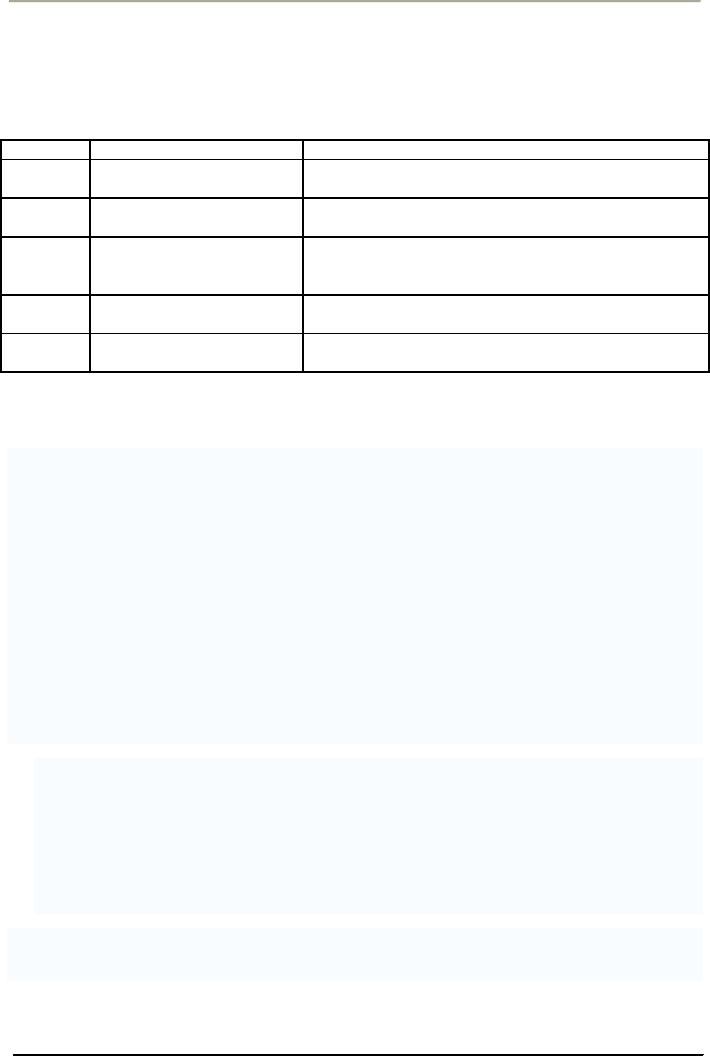 |

Total
Quality Management
MGT510
VU
Lesson
# 28
QUALITY
IN SOFTWARE SECTOR AND MATURITY
LEVELS
Performance
Maturity Levels
The
performance maturity levels used by
organizations are as
follows:
Maturity
Performance
level
Guidance
1
No
formal approach
No
systematic approach evident, no results,
poor results or
unpredictable
results.
2
Reactive
approach
Problem-
or prevention-based systematic
approach;
minimum
data on improvement results
available.
3
Stable
formal system
Systematic
process-based approach, early stage
of
approach
systematic
improvements; data available on
conformance
to
objectives and existence of improvement
trends.
4
Continual
improvement
Improvement
process in use; good results
and emphasized
emphasized
sustained
improvement trends.
5
Best-in-class
performance
Strongly
integrated improvement process;
best-in-class
bench
marked results demonstrated
Software
Engineering Institute's Capability
Maturity Model (CMMI) is also a generic
model of quality
improvement
and is focused on processes and systems
related to IT/Software sector.
Capability
Maturity Model (CMM)
broadly refers to a process improvement
approach that is based on
a
process model. CMM also refers
specifically to the first such
model, developed by the
Software
Engineering
Institute (SEI) in the mid-1980s, as
well as the family of process models
that followed. A
process
model is a structured collection of
practices that describe the
characteristics of effective
processes;
the practices included are
those proven by experience to be
effective.
The
Capability Maturity Model
can be used to assess an
organization against a scale of five
process
maturity
levels. Each level ranks the
organization according to its
standardization of processes in
the
subject
area being assessed. The
subject areas can be as diverse as
software engineering,
systems
engineering,
project management, risk
management, system acquisition,
information technology
(IT)
services
and personnel management.
The
Capability
Maturity Model (CMM)
is a way to develop and
refine an organization's
processes.
The
first CMM was for the
purpose of developing and refining
software development processes.
A
maturity
model is a structured collection of
elements that describe
characteristics of effective
processes.
A
maturity model
provides:
·
a
place to start
·
the
benefit of a community's prior
experiences
·
a
common language and a shared
vision
·
a
framework for prioritizing
actions
·
a
way to define what
improvement means for your
organization
A
maturity model can be used
as a benchmark for assessing
different organizations for
equivalent
comparison.
It describes the maturity of
the company based upon
the project the company is
dealing
with
and the clients.
124

Total
Quality Management
MGT510
VU
Structure
of CMM
Maturity
Levels
A
layered framework providing a progression
to the discipline needed to
engage
in continuous improvement (It is
important to state here that
an organization develops the
ability
to
assess the impact of a new practice,
technology, or tool on their
activity. Hence it is not a matter
of
adopting
these; rather it is a matter of determining
how innovative efforts
influence existing
practices.
This
really empowers projects, teams, and
organizations by giving them the
foundation to support
reasoned
choice.)
Key
Process Areas
Key
process area (KPA)
identifies a cluster of related
activities that, when
performed
collectively, achieve a set of goals considered
important.
Goals
The
goals of a key process area
summarize the states that
must exist for that
key process area to
have
been implemented in an effective and
lasting way. The extent to
which the goals have been
accomplished
is an indicator of how much
capability the organization has
established at that maturity
level.
The goals signify the scope, boundaries,
and intent of each key
process area.
Common
Features
Common
features include practices
that implement and institutionalize a
key
process
area. These five types of common
features include: Commitment to
Perform, Ability to
Perform,
Activities Performed, Measurement and Analysis, and
Verifying Implementation.
Key
Practices The
key practices describe the
elements of infrastructure and practice
that contribute
most
effectively to the implementation and
institutionalization of the key process
areas.
Levels
of the CMM
There
are five levels of the CMM.
According to the SEI,
Level
1 - Initial
At
maturity level 1, processes
are usually ad hoc and the
organization usually does
not provide a stable
environment.
Success in these organizations
depends on the competence and heroics of the
people in the
organization
and not on the use of proven
processes. In spite of this ad hoc,
chaotic environment,
maturity
level 1 organizations often produce
products and services that work;
however, they
frequently
exceed
the budget and schedule of their
projects.
Maturity
level 1 organizations are characterized
by a tendency to over commit, abandon
processes in the
time
of crisis, and not be able to
repeat their past successes
again.
Level
1 software project success
depends on having high
quality people.
Level
2 Repeatable
At
maturity level 2, software
development successes are repeatable.
The processes may not
repeat for all
the
projects in the organization. The
organization may use some
basic project management to
track cost
and
schedule.
Process
discipline helps ensure that
existing practices are
retained during times of stress.
When these
practices
are in place, projects are performed and
managed according to their documented
plans.
Project
status and the delivery of
services are visible to
management at defined points
(for example, at
major
milestones and at the completion of major
tasks).
Basic
project management processes
are established to track cost,
schedule, and functionality.
The
minimum
process discipline is in place to repeat
earlier successes on projects with
similar applications
and
scope. There is still a
significant risk of exceeding
cost and time
estimates.
125

Total
Quality Management
MGT510
VU
Level
3 Defined
The
organization's set of standard
processes, which is the basis
for level 3, is established and
improved
over
time. These standard
processes are used to establish
consistency across the organization.
Projects
establish
their defined processes by the
organization's set of standard
processes according to
tailoring
guidelines.
The
organization's management establishes
process objectives based on the
organization's set of
standard
processes and ensures that
these objectives are
appropriately addressed.
A
critical distinction between level 2 and
level 3 is the scope of standards,
process descriptions, and
procedures.
At level 2, the standards,
process descriptions, and procedures may
be quite different in
each
specific instance of the process
(for example, on a particular
project). At level 3, the
standards,
process
descriptions, and procedures for a
project are tailored from
the organization's set of
standard
processes
to suit a particular project or
organizational unit.
Level
4 - Managed
Using
precise measurements, management
can effectively control the
software development effort.
In
particular,
management can identify ways to adjust
and adapt the process to particular projects
without
measurable
losses of quality or deviations
from specifications. Organizations at
this level set
quantitative
quality goals for both software
process and software
maintenance.
Sub
processes are selected that
significantly contribute to overall
process performance. These
selected
sub
processes are controlled
using statistical and other
quantitative techniques.
A
critical distinction between maturity
level 3 and maturity level 4 is the
predictability of process
performance.
At maturity level 4, the performance of
processes is controlled using
statistical and other
quantitative
techniques, and is quantitatively predictable. At
maturity level 3, processes
are only
qualitatively
predictable.
Level
5 - Optimizing
Maturity
level 5 focuses on continually
improving process performance through
both incremental and
innovative
technological improvements. Quantitative
process-improvement objectives for
the
organization
are established, continually revised to
reflect changing business
objectives, and used as
criteria
in managing process improvement.
The effects of deployed process
improvements are
measured
and
evaluated against the quantitative process-improvement
objectives. Both the defined
processes and
the
organization's set of standard
processes are targets of
measurable improvement
activities.
Process
improvements to address common causes of
process variation and measurably
improve the
organization's
processes are identified,
evaluated, and deployed.
Optimizing processes that
are nimble,
adaptable
and innovative depends on the
participation of an empowered workforce
aligned with the
business
values and objectives of the organization.
The organization's ability to
rapidly respond to
changes
and opportunities is enhanced by finding
ways to accelerate and share
learning.
A
critical distinction between maturity
level 4 and maturity level 5 is the
type of process
variation
addressed.
At maturity level 4, processes
are concerned with
addressing special causes of
process
variation
and providing statistical predictability
of the results. Though processes
may produce
predictable
results, the results may be
insufficient to achieve the established
objectives. At maturity
level
5, processes are concerned
with addressing common causes of
process variation and changing
the
process
(that is, shifting the mean of the
process performance) to improve process
performance (while
maintaining
statistical probability) to achieve the established
quantitative process-improvement
objectives.
126
Table of Contents:
- OVERVIEW OF QUALITY MANAGEMENT:PROFESSIONAL MANAGERIAL ERA (1950)
- TOTAL QUALITY MANAGEMENT AND TOTAL ORGANIZATION EXCELLENCE:Measurement
- INTEGRATING PEOPLE AND PERFORMANCE THROUGH QUALITY MANAGEMENT
- FUNDAMENTALS OF TOTAL QUALITY AND RATERS VIEW:The Concept of Quality
- TOTAL QUALITY MANAGEMENT AND GLOBAL COMPETITIVE ADVANTAGE:Customer Focus
- TOTAL QUALITY MANAGEMENT AND PLANNING FOR QUALITY AT OFFICE
- LEADERS IN QUALITY REVOLUTION AND DEFINING FOR QUALITY:User-Based
- TAGUCHI LOSS FUNCTION AND QUALITY MANAGEMENT
- WTO, SHIFTING FOCUS OF CORPORATE CULTURE AND ORGANIZATIONAL MODEL OF MANAGEMENT
- HISTORY OF QUALITY MANAGEMENT PARADIGMS
- DEFINING QUALITY, QUALITY MANAGEMENT AND LINKS WITH PROFITABILITY
- LEARNING ABOUT QUALITY AND APPROACHES FROM QUALITY PHILOSOPHIES
- TOTAL QUALITY MANAGEMENT THEORIES EDWARD DEMING’S SYSTEM OF PROFOUND KNOWLEDGE
- DEMING’S PHILOSOPHY AND 14 POINTS FOR MANAGEMENT:The cost of quality
- DEMING CYCLE AND QUALITY TRILOGY:Juran’s Three Basic Steps to Progress
- JURAN AND CROSBY ON QUALITY AND QUALITY IS FREE:Quality Planning
- CROSBY’S CONCEPT OF COST OF QUALITY:Cost of Quality Attitude
- COSTS OF QUALITY AND RETURN ON QUALITY:Total Quality Costs
- OVERVIEW OF TOTAL QUALITY APPROACHES:The Future of Quality Management
- BUSINESS EXCELLENCE MODELS:Excellence in all functions
- DESIGNING ORGANIZATIONS FOR QUALITY:Customer focus, Leadership
- DEVELOPING ISO QMS FOR CERTIFICATION:Process approach
- ISO 9001(2000) QMS MANAGEMENT RESPONSIBILITY:Issues to be Considered
- ISO 9001(2000) QMS (CLAUSE # 6) RESOURCES MANAGEMENT:Training and Awareness
- ISO 9001(2000) (CLAUSE # 7) PRODUCT REALIZATION AND CUSTOMER RELATED PROCESSES
- ISO 9001(2000) QMS (CLAUSE # 7) CONTROL OF PRODUCTION AND SERVICES
- ISO 9001(2000) QMS (CLAUSE # 8) MEASUREMENT, ANALYSIS, AND IMPROVEMENT
- QUALITY IN SOFTWARE SECTOR AND MATURITY LEVELS:Structure of CMM
- INSTALLING AN ISO -9001 QM SYSTEM:Implementation, Audit and Registration
- CREATING BUSINESS EXCELLENCE:Elements of a Total Quality Culture
- CREATING QUALITY AT STRATEGIC, TACTICAL AND OPERATIONAL LEVEL
- BIG Q AND SMALL q LEADERSHIP FOR QUALITY:The roles of a Quality Leader
- STRATEGIC PLANNING FOR QUALITY AND ADVANCED QUALITY MANAGEMENT TOOLS
- HOSHIN KANRI AND STRATEGIC POLICY DEPLOYMENT:Senior Management
- QUALITY FUNCTION DEPLOYMENT (QFD) AND OTHER TOOLS FOR IMPLEMENTATION
- BASIC SQC IMPROVEMENT TOOLS:TOTAL QUALITY TOOLS DEFINED
- HOW QUALITY IS IMPLEMENTED? A DIALOGUE WITH A QUALITY MANAGER!
- CAUSE AND EFFECT DIAGRAM AND OTHER TOOLS OF QUALITY:Control Charts
- STATISTICAL PROCESS CONTROL (SPC) FOR CONTINUAL QUALITY IMPROVEMENT
- STATISTICAL PROCESS CONTROL….CONTD:Control Charts
- BUILDING QUALITY THROUGH SPC:Types of Data, Defining Process Capability
- AN INTERVIEW SESSION WITH OFFICERS OF A CMMI LEVEL 5 QUALITY IT PAKISTANI COMPANY
- TEAMWORK CULTURE FOR TQM:Steering Committees, Natural Work Teams
- UNDERSTANDING EMPOWERMENT FOR TQ AND CUSTOMER-SUPPLIER RELATIONSHIP
- CSR, INNOVATION, KNOWLEDGE MANAGEMENT AND INTRODUCING LEARNING ORGANIZATION